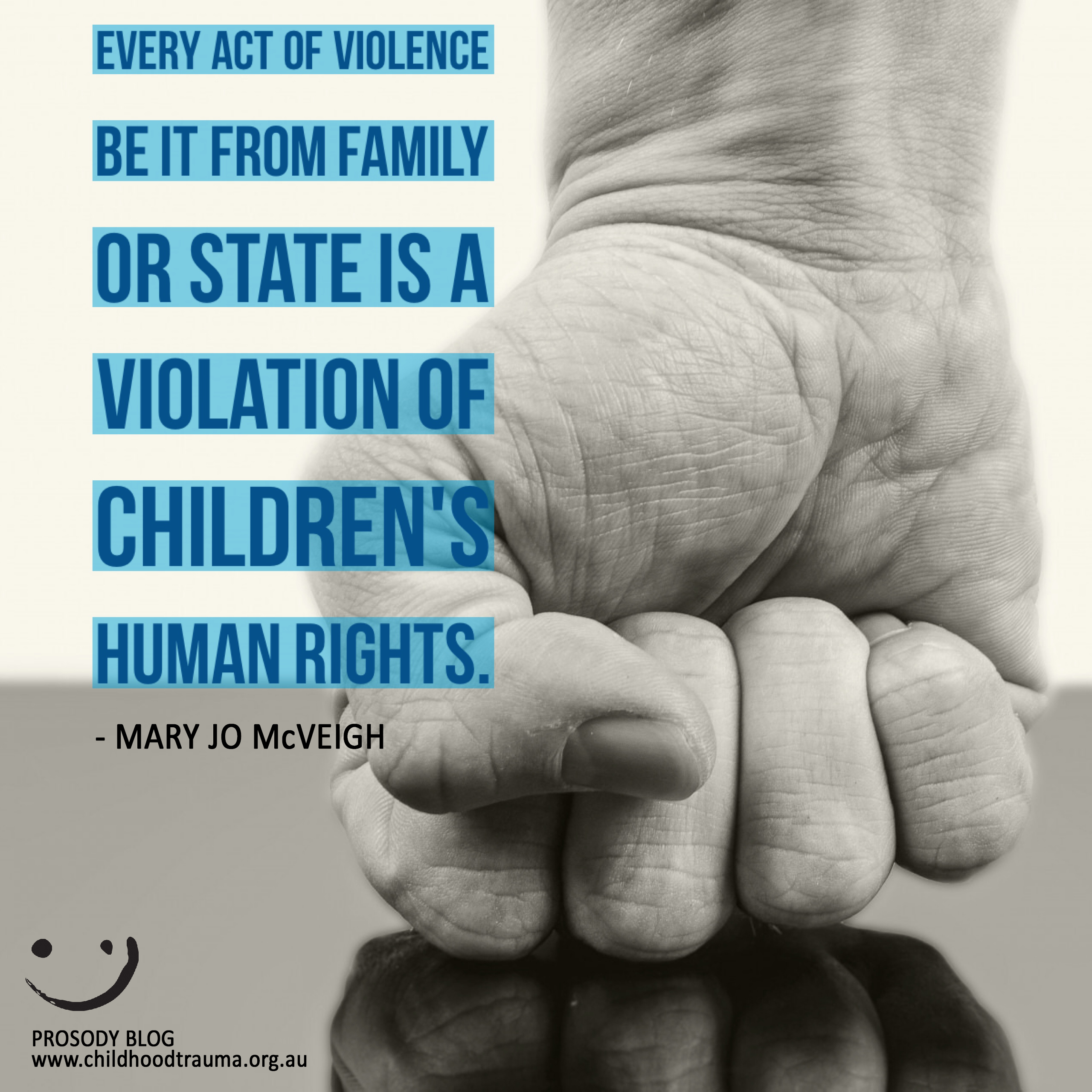
Where is Article 12?

This blog entry was authored by Mary Jo McVeigh, founder and CEO of Cara House and CaraCare. Mary Jo is a trained trauma therapist and an accredited mental health social worker with a passion for exploring and studying comprehensive bodies of knowledge bringing this emphasis for diversity of wisdom to her work. She is currently enrolled in undertaking a Doctor of Social work degree at Sydney University.
A CONSIDERATION OF THE PLACE OF HUMAN RIGHTS IN THE TRAUMA THERAPEUTIC DISCOURSE.
In 30 years of practice as a social worker and trauma therapist I have been deeply grateful to the researchers and practitioners that have illuminated for me the wisdom of neuro-biology. I have used this wisdom in the service of children, young people and adults oppressed by personal and political acts of violence and neglect.
Notwithstanding the bounty of this wisdom I have noticed my growing concern that the issue of trauma is predominantly framed in a minority world bio-medical model.
 Every act of violence be it from family or state is a violation of children’s human rights. The effects of the trauma is most certainly registered in the body. This message of violation being carried through the body by neuro peptides and hormones. However, if we as practitioners engage in a solely anatomical discourse we risk all our therapeutic interventions being at the mercy of paradigms that rely on adult centric medicalised knowledge. For example, Breggin (2014,) highlights vividly what he calls ‘the epidemic psychiatric drugging of children’, to control behaviour (p. 236), which results in ‘‘less child’ to get into trouble’, (p.232). In addition Van Daalen-Smith, Adam, Breggin and LeFrancois (2014) show how elector-shock treatment purposefully causes brain damage in children yet it has no scientific evidence to back up its effectiveness.
Every act of violence be it from family or state is a violation of children’s human rights. The effects of the trauma is most certainly registered in the body. This message of violation being carried through the body by neuro peptides and hormones. However, if we as practitioners engage in a solely anatomical discourse we risk all our therapeutic interventions being at the mercy of paradigms that rely on adult centric medicalised knowledge. For example, Breggin (2014,) highlights vividly what he calls ‘the epidemic psychiatric drugging of children’, to control behaviour (p. 236), which results in ‘‘less child’ to get into trouble’, (p.232). In addition Van Daalen-Smith, Adam, Breggin and LeFrancois (2014) show how elector-shock treatment purposefully causes brain damage in children yet it has no scientific evidence to back up its effectiveness.
LeFrançois and Coppock (2014, p.165) argue that ‘the rights of children diagnosed with psychiatric disorders are a neglected area in the field of childhood studies and the sociology of childhood.’ This is also true for children/young people who have been abused and receive therapeutic treatment (without or without a psychiatric diagnosis). If these rights are neglected then the methods that are being used go unquestioned.
Human rights
If we are to embrace trauma intervention as more than a neuro-biological issue then it is imperative that we honour our duty as signatory of the United Nations Convention on the Rights of the Child (UNCRC) and bring a human rights perspective into our daily practice.
A Human Rights perspective on trauma therapy is a rich landscape of ideas. Therefore in this blog I will focus on just one aspect. The aspect I presented at the recent International Childhood Trauma Conference – Article 12 of the UNCRC.
Article 12 of the UNCRC specifies the rights of children/young people to have input into decisions that affect their lives. The UNCRC has been ratified by 140 countries worldwide including Australia. In addition for the social workers working in the trauma field the profession has a clear mandate in its code of ethics to uphold participatory practices. Ethical guidelines pertaining to Social Justice (3.2), Respect for human dignity (5.1.1), Human rights (5.1.3) Social work service and propriety (5.1.4), Client self-determination (5.2.2), General approach to research (5.5.2.1) all promote individual, family, group and community participation.
Harry Shier (2001) contends that while Article 12 may be one of the most far reaching it is also the one that is least adhered to and mostly contravened. Therefore as part of my conference presentation I embarked upon a literature search to see how ‘contravened’ it is in the therapeutic field.
Literature Review
The approach that was taken was a systematic search of peer reviewed articles.
In all, 122 studies were reviewed. Only 7 focused directly on children/young people’s view of therapeutic intervention, (Capella, Lama, Rodríguez, Águila, Beiza, Dussert, Gutierrez, 2016; Carter, 2014; French et al, 2003; Hackett & Masson, 2006; Nelson-Gardell, 2001; Pycroft et al, 2015; Sudbery, Shardow & Huntington, 2010).
These studies were conducted by researchers post therapeutic intervention. They were not studies describing children/young people’s ongoing involvement in being active participants in service delivery or review.
Discussion
Shier’s (2001, p.110) model of participation looked at five levels:
- Children are listened to.
- Children are supported in expressing their views.
- Children’s views are taken into account.
- Children are involved in decision making processes.
- Children share power and responsibility for decision making.
The majority of therapy studies had none of these elements of participation. Though the interventions reviewed showed efficacy of results the privileging of data collection that subjects children/young people to a barrage of measures, collects their urine and does not ask for their input leaves their lived experience “dismissed as tainted or otherwise deemed as irrelevant,” (Head, 2008, p.5) and open to subjectification.
None of the studies showed that children/young people were consulted at the initial referral stage and few in any ongoing way.
In Cater’s (2014, p. 469) study she specifically stated that no children/young people were consulted at the initial phases and only a few ‘were provided opportunities to participate in the decision about actually starting the intervention.’ Worrall-Davies and Marino-Francis (2015) literature review found similar results but of greater concern was showing that practitioners did not change their practice regardless of feedback from children/young people.
However, the studies with some feedback from children did touch on three of the levels, children are listened to, children are supported in expressing their views and children’s views are taken into account. If being a signatory to the UNCRC is to be meaningful, and if seeing social work practice as a human rights issue then this imbalance between exclusion and inclusion of children/young people voices needs to be addressed and all of Shier’s five levels need to become common practice in best practice.
What did come from the literature may have been limited in the extent of its participation of children and young people but it was none the less extremely significant.
What Children/young people valued about the therapeutic intervention.
Themes emerged from the studies that highlighted what children/young people valued from their experience of therapeutic interventions. The central themes can be divided into three categories and are summarised in figure 1.
Figure 1: What children/young people want from therapy
|
Categories |
Theme emerging from the literature |
|
Service Delivery |
|
|
Characteristics of the therapist |
|
|
Children/young person’s needs. |
|
Practice
In therapeutic interventions with children/young people an emphasis must be given to what I have termed Rights Specific Practice. Rights Specific Practice must happen at all levels of the intervention and be achievable and measurable if it is to be meaningful to children/young people. It is a practice that joins the current professional discourse of body with human rights. Figure Four summarises the approach I have brought to my work and continue to develop in my service of children, young people and adults oppressed by acts of violence and abuse.
Figure 4: Rights Specific Practice
|
Rights Specific Practice |
|
|
Child/Young People |
Children/young people’s issues are considered from a human rights perspective. Children/young people are viewed from a competency lens. Children/young people have input into all levels of service delivery. |
|
Staff
|
Staff have knowledge of Human Rights paradigms especially UNCRC. Staff have knowledge and skills of rights specific therapeutic practices. Staff have knowledge and skills of children/young people inclusive therapeutic practices. Staff engage in ongoing reflective supervision and training on their ethics, knowledge and practices. |
|
Services
|
Service policy and procedural system reflect a Rights framework. Services are children/young people centred & inclusive. Services are delivered in a safe and creative manner conducive to a Right’s framework. Services are co-constructed and evaluated with children/young people.
|
References
Breggin, P.R. (2014). The Rights of Children and Parents in Regards to Children Receiving Psychiatric Diagnoses and Drugs. Children & Society, 28, 231-241.
Cantos, A.L., & Gries, L.T., (2010). Therapy Outcome with Children in Foster Care:A Longitudinal Study.Child Adolescent Social Work Journal, 27,133–149.
Capell, C., Lama, X., Rodríguez, Águila, D., Beiza, G., Dussert, D., Gutierrez, C., (2016) Winning a Race: Narrative of Healing and Psychotherapy in Children and Adolescents Who Have Been Sexaully Abused. Journal of Child Sexaul Abuse. 25:1, 73-92.
Cater, A.K., (2014). Chidlren’s Descriptions of Participation Processes in Interventions for Children Exposed to Intimate Partner Violence. Child Adolescent Social Work Journal, 31.455-473.
Castelino, T., (2009). Making Children’s Safety and Wellbeing Matter. Australian Social Work. 62:1, 61-73.
French, R., Readon, M., Smith, P., (2003). Engaging with a Mental Health Service: Perspectives of At-Risk Youth. Child and Adolescent Social Work Journal, 20:6, 529-548.
Gaskell, C., (2010). ‘If the Social Worker had Called at Least it Would Show they Cared.’ Young Care Leavers’ perspectives on the Importance of Care. Children & Society. 24,136-147.
Hackett, S., & Masson, H., (2006). Young People who have Sexually Abused: What do they (and their parents) want from Professionals? Children & Society, 20, 183-195.
Head, B.W., (2008). The Journal of Public Adminstration. 67(1):1-11
LeFrançois, B.A., Coppock, V. (2014).Psychiatrised Children and their Rights: Starting the Conversation. Children & Society, 28, 165-171.
Nelson-Gardell, D., (2001). The Voices of Victims: Surviving Child Sexual Abuse. Child and Adolescent Social Work Journal, 18:6, 401-416.
Purvis, K.B., McKenzie, L.B., Razuri, E.B., Cross, D.R., Buckwalter, K., (2014). A Trust Based Intervention for Complex Developmental Trauma: A Case Study from a Residential Treatment Center. Child Adolescent Social Work Journal 31, 355-368.
Pycroft, A., Wallis, A., Bigg, J., Webster, G. (2015). Participation, engagement and Change: A Study of the Experiences of Service Users of the Unified Adolescent Team. British Journal of Social Work. 45, 422-439.
Shier, H. (2001). Pathways to Participation: Openings, Opportunities and Obligations. A New Model for Enhancing Children’s Participation in Decision-making, in line with Article 12.1 of the United Nations Convention on the Rights of the Child. Children & Society, 15, 107-117.
Shier, H., Méndez, M.H., Centeno, M., Arróloga, González, M., (2014). How Children and Young People Influence Policy-Makers: Lessons from Nicaragua. Children & Society, 28, 1-14.
Sudbery, J., Shardlow, S.M., Huntington, A.E. (2010). To Have and to Hold: Questions abuot a Therapeutic Service for Children. The British Jounral of Social Work. 40:5,1534-1552.
Worrall-Davies, A. and Marino-Francis, F., (2008). ‘Eliciting children’s and young person’s views of child and adolescent mental health services; A systemic review of best practice’. Child and Adolescent Mental Health, 13:1, 9-15.
